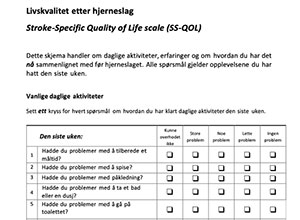Forskning
Livskvalitet etter hjerneslag
Stroke-Specific Quality of Life scale (SS-QOL)
Skjema oversatt til norsk til bruk i forskning og kartlegging. Skjemaet handler om daglige aktiviteter, erfaringer og om hvordan personen har det nå sammenlignet med før hjerneslaget. Alle spørsmål gjelder opplevelsene personen har hatt den siste uken.
Change characteristics of health-related quality of life and its association with post-stroke fatigue at four-year follow up
Synne G. Pedersen, Audny Anke, Mari T. Løkholm, Marianne B. Halvorsen, Marit Kirkevold, Guri Heiberg, Marte Ørbo, Oddgeir Friborg (2024)
The long-term consequences of stroke may be highly individual and multifaceted. The aim of this study was to explore trajectories that describe change in health-related quality of life between 1 and 4 years after stroke, and the diverse trajectories’ association with post-stroke fatigue at 4-year follow-up.
Visual problems are associated with long-term fatigue after stroke
Synne G. Pedersen, Mari T. Løkholm, Oddgeir Friborg, Marianne B. Halvorsen, Marit Kirkevold, Guri Heiberg, Audny Anke (2023)
Post-stroke fatigue may be associated with functioning even in patients with mild stroke. In order to guide rehabilitation, the aim of this study was to investigate the independent contribution of 12 function-related domains to severe long-term fatigue.
Effect of innovative vs. usual care physical therapy in subacute rehabilitation after stroke. A multicenter randomized controlled trial
Marianne Sivertsen, Ellen Christin Arntzen, Karl Bjørnar Alstadhaug, Britt Normann (2022)
Research on stroke rehabilitation often addresses common difficulties such as gait, balance or physical activity separately, a fragmentation contrasting the complexity in clinical practice. Interventions aiming for recovery are needed. The purpose of this study was to investigate effects of a comprehensive low-cost physical therapy intervention, ICoreDIST, vs. usual care on postural control, balance, gait and health-related quality of life during the first 12 weeks post-stroke.
The precarity of patient participation – a qualitative interview study of experiences from the acute stroke and rehabilitation journey
Marianne Sivertsen, Hanne De Jaegher, Karl Bjørnar Alstadhaug, Ellen Christin Arntzen, Britt Normann (2022)
Active patient participation is an important factor in optimizing post-stroke recovery, yet it is often low, regardless of stroke severity. The reasons behind this trend are unclear. The purpose of this study was to explore how people who have suffered a stroke, perceive the transition from independence to dependence and whether their role in post-stroke rehabilitation influences active participation.
Embodiment, tailoring, and trust are important for co-construction of meaning in physiotherapy after stroke: A qualitative study
Marianne Sivertsen, Hanne De Jaegher, Ellen Christin Arntzen, Bjørnar Alstadhaug, Britt Normann (2022)
Physiotherapy, with an emphasis on high intensity, individually tailored, and person‐centered treatment, is an effective route for recovery after a stroke. No single approach, however, has been deemed paramount, and there is limited knowledge about the patient experience of assessment, goal‐setting, andtreatment in physiotherapy. In this study, we seek to report patient experiences of I‐CoreDIST—a new physiotherapy intervention that targets recovery—and those of usual care. The purpose is to investigate how individuals with stroke experience the bodily and interactive course of physiotherapy during their recovery process.
Factors associated with met and unmet rehabilitation needs after stroke: A multicenter cohort study in Denmark and Norway
Guri Heiberg, Cecilie Røe, Oddgeir Friborg, Synne G. Pedersen, Henriette H. Stabel, Jørgen F. Nielsen, Audny Anke (2021)
The objectives of this study was to examine patient-reported needs for care and rehabilitation in a cohort following different subacute pathways of rehabilitation, and to explore factors underpinning met and unmet needs.
Post-stroke health-related quality of life at 3 and 12 months and predictors of change in a Danish and arctic Norwegian region
Guri Heiberg, Oddgeir Friborg, Synne G. Pedersen, Gyrd Thrane, Henriette H. Stabel, Jørgen F. Nielsen, Audny Anke (2020)
The aims of this study were to investigate changes in health-related quality of life between 3- and 12-months post-stroke in a north Norwegian and a Danish region that organize their rehabilitation services differently, and to identify clinically relevant predictors of change.
Stroke-Specific Quality of Life one-year post-stroke in two Scandinavian country-regions with different organisation of rehabilitation services: a prospective study
Synne Garder Pedersen, Oddgeir Friborg, Guri A. Heiberg, Cathrine Arntzen, Henriette H. Stabel, Gyrd Thrane, Jørgen F. Nielsen, Audny Anke (2020)
The purpose of this study were to compare stroke-specific health related quality of life in two country-regions with organisational differences in subacute rehabilitation services, and to reveal whether organisational factors or individual factors impact outcome.
Experiences of quality of life the first year after stroke in Denmark and Norway. A qualitative analysis
Synne Garder Pedersen, Audny Anke, Lena Aadal, Hanne Pallesen, Siri Moe, Cathrine Arntzen (2019)
This study explore quality of life (QOL) during the first year of recovery after stroke in North Norway and Central Denmark
Comprehensive core stability intervention and coordination of care in acute and subacute stroke rehabilitation—a pilot study
Britt Normann, Ellen Christin Arntzen, Marianne Sivertsen (2018)
This study investigates the feasibility and preliminary effects of a new intervention emphasising core stability training integrated in functional activity (ICoreDIST), supported by clinical Skype sessions to coordinate between health care levels among acute stroke patients.
Can the health related quality of life measure QOLIBRI – overall scale (OS) be of use after stroke? A validation study
Guri Heiberg, Synne Garder Pedersen, Oddgeir Friborg, Jørgen Feldbæk Nielsen, Henriette Holm Stabel, Nicole von Steinbüchel, Cathrine Arntzen, Audny Anke (2018)
Brief measures of health-related quality of life (HRQOL) that assess both patient-reported functioning and well-being after stroke are scarce. The objective of this study was to examine reliability and validity of one of these measures, the patient-reported Quality of Life after Brain Injury (QOLIBRI-OS), in patients after stroke.
Validity, reliability and Norwegian adaptation of the Stroke-Specific Quality of Life (SS-QOL) scale
Synne Garder Pedersen, Guri Anita Heiberg, Jørgen Feldbæk Nielsen, Oddgeir Friborg, Henriette Holm Stabel, Audny Anke, Cathrine Arntzen (2018)
There is a paucity of stroke-specific instruments to assess health-related quality of life in the Norwegian language. The objective of this study was to examine the validity and reliability of a Norwegian version of the 12-domain Stroke-Specific Quality of Life scale.
